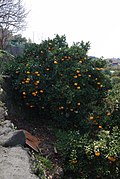Amanatsu
- Amanatsu
-
Citrus kawanonatsudaidai fruit
-
Citrus kawanonatsudaidai
-
Citrus natsudaidai
-
Gardens with natsumikans in Hagi
-
Amanatsu trees on Nokonoshima Island
-
Citrus natsudaidai Melanose
-
Natsudaidai
-
Kusune Citrus natsudaidai
Amanatsu[edit]
Amanatsu (also known as amanatsu mikan or natsumikan) is a type of citrus fruit that is native to Japan. It is a hybrid fruit, believed to be a natural cross between a pomelo and an orange. The fruit is known for its sweet and slightly tart flavor, making it a popular choice for consumption in various forms.
Description[edit]
Amanatsu fruits are medium to large in size, with a bright yellow to orange skin that is relatively thick and easy to peel. The flesh of the fruit is juicy and segmented, similar to other citrus fruits. The taste of amanatsu is a balance of sweetness and acidity, which makes it refreshing and enjoyable to eat.
Cultivation[edit]
Amanatsu is primarily grown in the Yamaguchi Prefecture and other regions of Japan with a suitable climate for citrus cultivation. The trees thrive in well-drained soil and require a warm climate with plenty of sunlight. The fruit is typically harvested in the late winter to early spring months.
Uses[edit]
Amanatsu can be eaten fresh, juiced, or used in cooking and baking. It is often used to make marmalades, desserts, and beverages. The zest of the fruit is also used to add flavor to various dishes. In addition to its culinary uses, amanatsu is sometimes used in traditional Japanese medicine for its potential health benefits.
Nutritional Value[edit]
Like other citrus fruits, amanatsu is rich in vitamin C, which is important for maintaining a healthy immune system. It also contains dietary fiber, potassium, and other essential nutrients. The fruit is low in calories, making it a healthy snack option.
Related Pages[edit]
Ad. Transform your life with W8MD's Budget GLP-1 injections from $75


W8MD offers a medical weight loss program to lose weight in Philadelphia. Our physician-supervised medical weight loss provides:
- Weight loss injections in NYC (generic and brand names):
- Zepbound / Mounjaro, Wegovy / Ozempic, Saxenda
- Most insurances accepted or discounted self-pay rates. We will obtain insurance prior authorizations if needed.
- Generic GLP1 weight loss injections from $75 for the starting dose.
- Also offer prescription weight loss medications including Phentermine, Qsymia, Diethylpropion, Contrave etc.
NYC weight loss doctor appointmentsNYC weight loss doctor appointments
Start your NYC weight loss journey today at our NYC medical weight loss and Philadelphia medical weight loss clinics.
- Call 718-946-5500 to lose weight in NYC or for medical weight loss in Philadelphia 215-676-2334.
- Tags:NYC medical weight loss, Philadelphia lose weight Zepbound NYC, Budget GLP1 weight loss injections, Wegovy Philadelphia, Wegovy NYC, Philadelphia medical weight loss, Brookly weight loss and Wegovy NYC
|
WikiMD's Wellness Encyclopedia |
| Let Food Be Thy Medicine Medicine Thy Food - Hippocrates |
Medical Disclaimer: WikiMD is not a substitute for professional medical advice. The information on WikiMD is provided as an information resource only, may be incorrect, outdated or misleading, and is not to be used or relied on for any diagnostic or treatment purposes. Please consult your health care provider before making any healthcare decisions or for guidance about a specific medical condition. WikiMD expressly disclaims responsibility, and shall have no liability, for any damages, loss, injury, or liability whatsoever suffered as a result of your reliance on the information contained in this site. By visiting this site you agree to the foregoing terms and conditions, which may from time to time be changed or supplemented by WikiMD. If you do not agree to the foregoing terms and conditions, you should not enter or use this site. See full disclaimer.
Credits:Most images are courtesy of Wikimedia commons, and templates, categories Wikipedia, licensed under CC BY SA or similar.
Translate this page: - East Asian
中文,
日本,
한국어,
South Asian
हिन्दी,
தமிழ்,
తెలుగు,
Urdu,
ಕನ್ನಡ,
Southeast Asian
Indonesian,
Vietnamese,
Thai,
မြန်မာဘာသာ,
বাংলা
European
español,
Deutsch,
français,
Greek,
português do Brasil,
polski,
română,
русский,
Nederlands,
norsk,
svenska,
suomi,
Italian
Middle Eastern & African
عربى,
Turkish,
Persian,
Hebrew,
Afrikaans,
isiZulu,
Kiswahili,
Other
Bulgarian,
Hungarian,
Czech,
Swedish,
മലയാളം,
मराठी,
ਪੰਜਾਬੀ,
ગુજરાતી,
Portuguese,
Ukrainian







